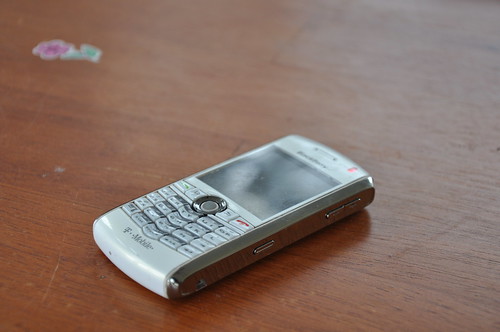I was messing around with my D90 today and was thinking about lightboxes. If you’re not familiar with a lightbox, it’s a controlled photo environment, like a pint-sized studio, that lets you take close up shots of items for sites like eBay or Craigslist. Most of the systems out there for amateurs rage from 25 –100 – which for what a lightbox does, seems awfully pricey. I decided to see what I could do at home with a small amount of materials on the cheap.
I started with my phone in normal daylight, no flash. This was shot with a Nikon D90, aperture priority, 65mm f/5.3, no flash, on a tripod.
Not phenomenal, but good enough for a basic auction site. Next, I added two sheets of white paper beneath it.
So far, still not breaking the budget. The white background does help isolate the phone from its surroundings, but it’s still not quite what I want. I got a dirt cheap acrylic photo frame – the kind you can buy in the office supplies section of Walmart for 3 for $1 – all clear plastic, L shaped – and taped a piece of paper to it. I put this behind the phone to filter some of the daylight.
All that screen glare and reflection has now gone away.
With a bit of judicious cropping and a quick auto adjust in iPhoto, my phone looks far better than it really is:
The actual cost of this project? Literally pennies for the paper and call it 50 cents for the acrylic frame as a light filter. Now, is this as good as professional lightbox system? No, not at all. Is it good enough for what most people need to put up an item on an auction site? You bet. Do this and you’re ahead of 99% of the crowd that takes a picture with a handheld and a way-too-close flash. You can add more lighting and photo frames as needed – you’ll probably end up buying the pack of 3 anyway.
Disclosure: any Amazon links in this post go to my employer, the Student Loan Network, and earn a nominal commission.
Did you enjoy this blog post? If so, please subscribe right now!
Get this and other great articles from the source at www.ChristopherSPenn.com







Leave a Reply